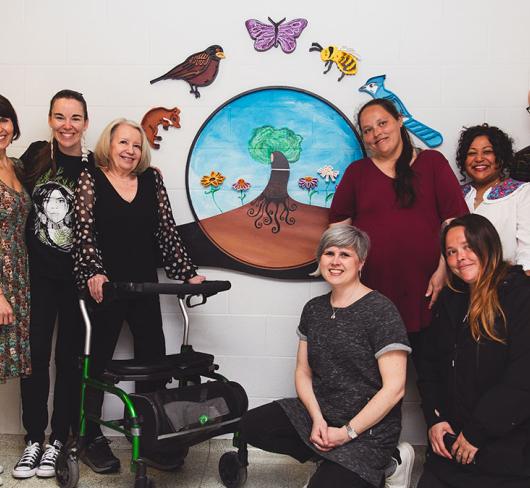
Violence Against Women – It's Happening at School
Violence against women is such a pervasive problem that just uttering the words conjures up thoughts of women, girls, trans and non-binary people who have experienced physical, sexual and emotional abuse. Referred to as women abuse, domestic violence or intimate partner violence, it all falls into the category of gender-based violence, “harmful acts directed at an individual based on their gender.” (UNHCR)
Gender-based violence is thought of as something that happens behind closed doors in a home or on a dark street late at night. It’s important for workers and employers to remember that it can also happen at work. According to Statistics Canada, one in four victims of violent crime (26 percent) report that the incident happened in their workplace.
Asked what job experiences the most violence, many might name police officers. However, statistics from the WSIB(2018) show that police officers actually came third, close behind correctional officers. Which job classification was first? Educational assistants in elementary and secondary schools. (See ETFO’s “The Top Twenty in 2018” document.)
Education workers know that violence against educators has been on the rise. According to a University of Ottawa report, Facing the Facts: The Escalating Crisis of Violence Against Elementary School Educators in Ontario, educators who were surveyed in 2017 reported having experienced a sevenfold increase in violence since 2005, going from seven percent to 54 percent of educators reporting they had experienced violence in their careers.
What is the connection between gender-based violence and workplace violence for education workers?
- Women make up the majority of elementary school teachers in Ontario. The numbers are even higher for Designated Early Childhood Educators and Educational Assistants. If there is violence against workers in schools, it is women who are experiencing it.
- A study from the Institute of Work and Health that reviewed work-related injuries from 2002 to 2015 found the risk of workplace violence for women working in education rose over that time period when compared to men.
- Intimate partner violence can follow people to their workplace and is recognized as being disproportionately experienced by women. In 2019, the vast majority (79 percent) of victims of intimate partner violence reported to police were women.
- The systemic indifference that leads to some educators being told they caused the violence or that violence was a part of the job seems very familiar to women who have been held responsible for the violence of others in other settings (Why don’t you leave? What did you expect?).
- The Canadian Labour Congress’ study with the University of Western Ontario found that reports of harassment and violence are much higher for gender-diverse individuals (78 percent) compared to 46 percent of women and 38 percent of men.
Most violence in schools can be divided into three categories:
- Intimate partner or domestic violence that has carried over into the workplace,
- violence and harassment carried out by other adults at work such as supervisors, co-workers or students’ family members, and
- most prevalent, violent behaviour from students.
It’s important to understand that the employer’s responsibility exists in spite of privacy concerns. No more information than is necessary to protect workers should be shared, but workers must be notified of the risk of violence in the workplace and they must be protected.
Domestic Violence
“Domestic violence” is specifically addressed in the Occupational Health and Safety Act (OHSA). Employers must take every precaution reasonable to protect a worker if they are aware (or ought to be aware) that the worker may be at risk of physical injury in the workplace from domestic violence. Advancements like this in occupational health and safety often come as a result of workplace injuries or fatalities. In this instance, the case of Lori Dupont, a nurse who was killed at work by her ex-partner in 2005, was a catalyst for the addition of domestic violence to the OHSA.
Adult Violence
Violent behaviour by adults, whether they are a colleague or a community member, also poses a risk to workers. In Section 32 of the OHSA, violence and harassment are addressed together although not all jurisdictions recognize that harassment can be a form of violence. There is a continuum from non-physical acts like bullying, harassment, verbal hostility and threats up to physical violence. They are not unrelated issues, and concerns about non-physical acts shouldn’t be minimized just because they don’t cause physical injury.
Once again, it was a workplace fatality that led to improvements in the OHSA. Theresa Vince experienced sexual harassment at work that eventually escalated to physical violence and she was killed by her supervisor. The deaths of Theresa Vince and Lori Dupont both led to recommendations that resulted in the amendment to the OHSA, Section 32.0 Violence and Harassment. It includes a requirement for boards to have a policy that includes how to summon help and how to report violence or harassment.
Violent Behaviour of Students
Most violence experienced by educators comes from students. Any student who is so dysregulated that they are violent toward an adult is likely struggling and may have mental health or special education needs.
Educators reporting violent behaviour by students are often dismissed:
- How much could a Kindergarten student possibly hurt you?
- They’re having a bad day.
- They don’t understand what they are doing.
- This is just a part of the job in a public education system welcoming all students.
- This student has a right to an education.
These are excuses and should not be used to absolve supervisors and employers of responsibility. The intent of the student (which may not be to harm or hurt) is separate from the impact on the worker who still experiences these acts as violence. And the OHSA is clear that “despite anything in any general or special act, the provisions of this Act and the regulations prevail.” In other words, safety trumps all, and the responsibility of the employer to keep workers safe comes before their other obligations.
The increase in school violence, especially by students, is unlikely to be solved by tweaking a safety plan or providing more training to educators. It is a result of underfunding; supports like specialized staff and resources have been cut back. In the broader community, the professionals who would help these struggling students and their families are non-existent, under-funded or out of reach to those without benefits or financial resources.
The last “normal” school year for students and educators in Ontario was 2019-2020. Since March 2020, school has been disrupted by periods of virtual learning, schools adapting to pandemic protocols and shifts in staffing. During periods when many students were learning remotely, obviously reports of violent incidents went down. But how the level of violence in schools will be affected by this period is uncertain. Nonetheless, we do know the appropriate supports for struggling students are still not in place, students have lost their familiarity with school routines, the needed staffing is not in place, education workers have reported high levels of anxiety and burnout and all Ontarians have lived through a difficult and uncertain time. In the absence of a provincial government that will fund education and other social services appropriately it seems likely that violence in school will continue to be an issue.
Workplace violence is not acceptable and it is not an inherent part of being an educator. Workers have the right to go home safe at the end of their workday. The employer has the responsibility for the safety of everyone in a school. Workers have the responsibility to report hazards. If you are experiencing or at risk of violence or harassment at work:
- Tell your administrator.
- Report all incidents (including attempts and threats).
- Call your ETFO local if you need support.
- Remember your right to refuse unsafe work. Find out more: etfohealthandsafety.ca/site/workplace-violence/
Elizabeth Mitchell is a member of the ETFO executive staff.

